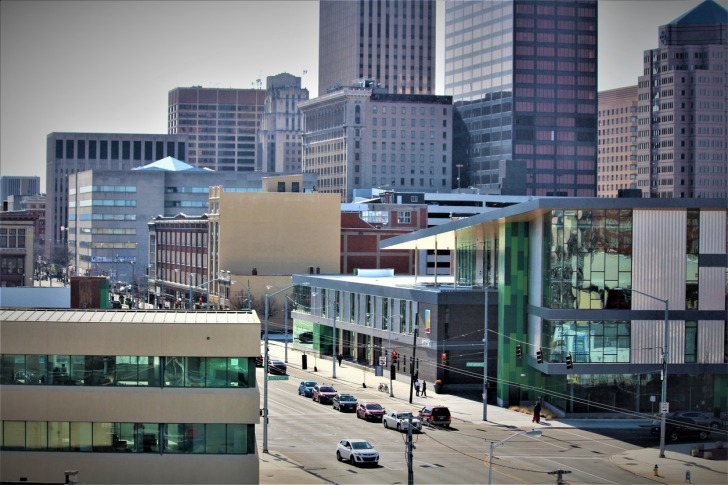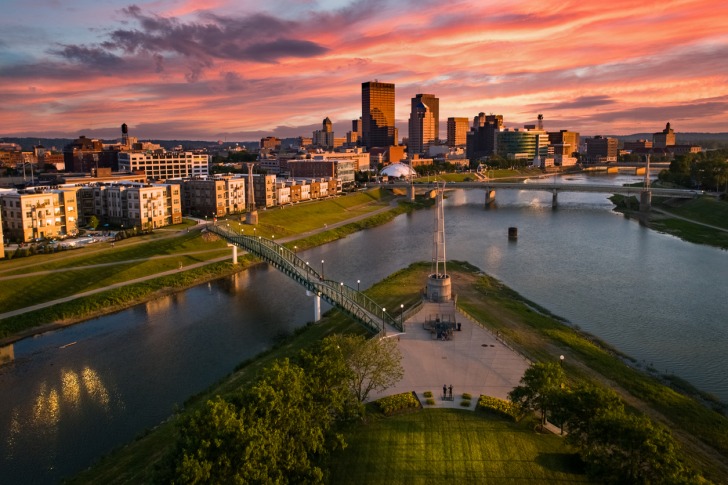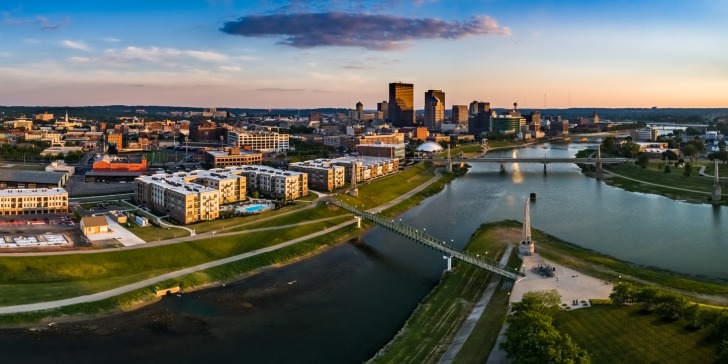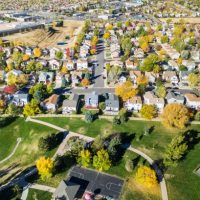Dayton is the county seat of Montgomery County, Ohio, and the sixth most populous city in Ohio.
The U.S. Census Bureau indicates that there were an estimated 135,944 residents, as of July 1, 2022.
The city is known for its rich history, and for being the home of famous inventors, writers, and noted business professionals. It is also the home of several well-known musicians.
Living in a city that is the birthplace of so many famous people is a source of pride for Daytonians.
Learn the pros and cons of living in Dayton, Ohio before moving to the city.

Contents
Pros of Living in Dayton, Ohio
1. Low Cost of Living
The cost of living in Dayton, Ohio is considerably lower when compared to many other areas of the country.
It is also less expensive to live in Dayton than in several other Ohio cities.
A comparison between Dayton and Scottsdale, Arizona shows that the cost of living in Dayton is 16.1 percent lower than the cost of living in Scottsdale.
Dayton has a 24.6 lower cost of living than the cost of living in Denver, Colorado.
It is less expensive to live in Dayton than it is to live in Columbus, Cincinnati, or Akron, Ohio.
2. Birthplace of Aviation, Inventors, Musicians, and Entrepreneurs
Several people who were born or raised in Dayton helped shape the country and the world through their inventions and their contributions to writing, music, and business.
Wilbur Wright and Orville Wright shared a passion for the newspaper that they wrote and published in Dayton, and for building and working on bicycles.
The Wright Brothers worked tirelessly trying to design wings for flight.
The brothers flew their first plane at Kitty Hawk, creating their place in history.
Famed poet Paul Laurence Dunbar was an elevator operator in Dayton, who wrote poetry in his spare time.
He read his poetry to many notable people in the U.S. and abroad.
His books of poetry and other writings are still famous and beloved today.
John H. Patterson was the founder of the National Cash Register Company (NCR).
The entrepreneur and industrialist is considered the Father of Modern Sales.
Rock legend Robert Pollard was born in Dayton, as was Tommy James, of the group Tommy James and the Shondells.
Several music groups started their career in Dayton.
3. Things to See and Do
Dayton has many things for residents to see and do.
There is something for everyone, including museums, parks, entertainment, and sports.
The National Museum of the U.S. Air Force is a free attraction.
It is the world’s oldest and largest military aviation museum.
See hundreds of military planes, artifacts, and aerospace vehicles.
Walk through a NASA shuttle, or sit in the cockpit of a B-2 stealth bomber.
The Boonshoft Museum of Discovery features interactive displays for kids of all ages.
The Discovery and Science Museum features many types of exhibits, including examples of paleontology, anthropology, and geology.
The Dayton Ballet, the Philharmonic Orchestra, and the Dayton Art Institute are sources of pride for Dayton residents.
Visit the Sunwatch Indian Village and Archeological Park, a National Historic Landmark site.
Native Americans inhabited the site 800 years ago.
The Dayton Dragons, a minor league baseball team, entertains baseball fans, while college and high school sports teams also entertain sports enthusiasts.
4. Mean Travel Time to Work
The mean travel time to work for people who live in the Dayton area is lower than the national average.
The U.S. Census Bureau reported in 2019 that the average one-way travel time to work in the U.S. increased to 27.6 minutes, which was up from 25 minutes.
The average one-way commute time to work for Dayton residents is 20.8 minutes.
5. Parks and Outdoor Recreation
The park system in Dayton, Ohio comprises more than 16,000 acres of space across 30 locations.
The mission of the Five Rivers MetroPark System is to protect the natural heritage of the region, and to provide people with an outdoor experience that inspires “a personal connection with nature.”
Some locations and facilities that are part of the nationally accredited parks system include Aullwood Garden, Cox Arboretum, RiverScape, and Wegerzyn Gardens.
Dayton received an award for its biking trails, which residents enjoy, along with the many hiking and walking trails.
6. Research, Development, and Innovation
Dayton has strong ties to research, development, and innovation.
BusinessWeek named Dayton, Ohio as one of the fastest-growing cities for tech jobs.
Several research facilities and labs make their home in Dayton.
The University of Dayton Research Institute has several research partners.
It conducted more than $221 million in sponsored research in 2022.
It is the number one university of all colleges and universities across the U.S. for sponsored research and development in materials engineering.
7. Housing Costs
Housing costs in Dayton, Ohio are lower than in many other Ohio cities.
Forbes Advisor lists the median home price in Ohio as $235,000.
The median listing home price in Dayton, as of August 2023, is $150,000.
Home buyers thinking of moving to Dayton want to be aware that although the cost of a home in the area is lower than the state and the national average, Dayton home prices are trending upward.
Rental costs are also trending upward in Dayton, although monthly rental costs are lower than in many other areas.
8. Diverse Employment Sectors
Dayton’s diverse employment sectors attract new residents and help to retain Dayton’s current residents.
Technology and aviation have made their mark on the region, but healthcare, logistics, manufacturing, and services provide employment for many residents.
The Dayton, Ohio restaurants and other food service options provide plenty of jobs for first-time job seekers, students, and long-term food service workers.
Cons of Living in Dayton, Ohio
1. Public Transportation System
Dayton’s public bus transportation system has a reputation among many Dayton residents for cutting service to some areas, lengthening the number of buses that people must take to get where they need to go, and eliminating complete routes.
The RTA operates in Downtown Dayton via a bus hub.
The buses pull into the hub to let people off and on the bus.
The hub used to be an alleyway years ago.
The crowded, narrow sidewalk has been a source of trouble, including large groups of teenagers, fights, and some violent acts, including shootings near the hub.
Some residents indicate that their complaints to RTA and to Dayton City leaders seem to be ignored.
There is no light rail system or widely recognized taxi service in Dayton.
2. Vacant Houses and Businesses
The high number of vacant homes and businesses gives a blighted look to some neighborhoods.
Dayton’s vacant buildings are sometimes an attraction for people committing crimes or for the homeless looking for a place to sleep.
Dayton city leaders are aware of the issues and complaints regarding these buildings and neighborhoods.
3. High Poverty Rate
Dayton has a high poverty rate.
The poverty rate has continually increased for several years.
A headline in The Dayton Daily News in September 2020 reads, “Dayton has one of the highest poverty rates in the nation.”
The U.S. Census Bureau reported in 2021 that 28.6 percent of Dayton residents live in poverty.
4. Noisy Neighbors
Dayton has several colleges and universities.
Many college students live off campus in several Dayton apartment complexes and in rental homes.
Dozens of college students who party into the wee hours of the morning at the apartment complex or in the neighborhood where their rental home is located may not appeal to other residents who want to sleep at night.
5. High Drug Use and Overdoses
Dayton government and social service leaders recognize that the city has a chronic drug problem.
The city’s drug problem has been an issue for several years.
Dayton ranked number one in the country for drug overdoses in 2016. Opioid overdoses increased by 60 percent in 2020.
Some agencies closed while others merged, which may have reduced the services for substance abuse treatment.
Fentanyl, Xanax, meth, and alcohol are some of the drugs attributed to the drug overdoses that occur in Dayton.
6. Low Median Household Income
The low median household income is likely one reason that Dayton has a high poverty rate.
The salary that many people earn is often not livable wages for people to have a comfortable lifestyle.
The 2021 median household income for Dayton was $37,536.
7. Public School System
Dayton’s public school system often receives low ratings.
Public School Review gave Dayton’s public schools a score of two out of a possible high score of 10.
The school system received a grade of C- at Niche.
Students who attend school in Dayton have low test scores.
There were only 21 percent of students who tested proficient in reading and only 12 percent of students who tested proficient in math.
8. High Crime Rate
Dayton, Ohio has a high crime rate that is above the state and national averages.
The crime rate in the city is 98 percent higher than the national average.
The violent crime rate is 167 percent higher than the national average.
There were 309 violent crimes reported per 100,000 people in Ohio in 2021.
Statistics show that there were 388 violent crimes per 100,000 people in the nation.
Dayton reported 1,035 violent crimes per 100,000 people.
The violent crimes included murder, rape, robbery, and assault.

Pros and Cons of Living in Dayton, OH – Summary Table
| Pros of Living in Dayton, Ohio | Cons of Living in Dayton, Ohio |
|---|---|
| 1. Low Cost of Living | 1. Public Transportation System |
| 2. Birthplace of Aviation, Inventors, Musicians, and Entrepreneurs | 2. Vacant Houses and Businesses |
| 3. Things to See and Do | 3. High Poverty Rate |
| 4. Mean Travel Time to Work | 4. Noisy Neighbors |
| 5. Parks and Outdoor Recreation | 5. High Drug Use and Overdoses |
| 6. Research, Development, and Innovation | 6. Low Median Household Income |
| 7. Housing Costs | 7. Public School System |
| 8. Diverse Employment Sectors | 8. High Crime Rate |
Dayton Safety Overview
READ THE FULL REPORT: Dayton Safety Review
Safety Index:
- OVERALL RISK: MEDIUM
- TRANSPORT & TAXIS RISK: LOW
- PICKPOCKETS RISK: MEDIUM
- NATURAL DISASTERS RISK: MEDIUM
- MUGGING RISK: MEDIUM
- TERRORISM RISK: LOW
- SCAMS RISK: LOW
- WOMEN TRAVELERS RISK: MEDIUM
Frequently Asked Questions
How much annual snowfall is there in Dayton?
Snow falls in Dayton on an average of 26.5 days a year.
The average annual snowfall is 25 inches.
What is the coldest month of the year in Dayton?
January is the coldest month in Dayton, Ohio.
The average temperature in Dayton in January is 29 degrees Fahrenheit.
Is Dayton a walkable city?
Walk to local stores, shops, healthcare facilities, and parks in and around Dayton.
Many schools are within easy walking distance.
Is Dayton pet-friendly?
Residents enjoy the fact that Dayton is a pet-friendly city.
Parks and recreation areas provide residents with the opportunity to bring their dogs along for exercise and fun.
Some apartment communities and other rental properties may restrict the type of pet allowed or may specify pet weight limits.
Does Dayton have good neighborhoods?
Dayton has several good neighborhoods and suburbs. Kettering, Centerville, Washington Township, and Huber Heights are examples of the areas that many people choose when looking for good neighborhoods.












Dayton, Ohio offers a low cost of living, rich history, and diverse employment sectors, making it a great place to live for those on a budget or looking for unique experiences. However, the city also faces challenges such as high poverty and crime rates, making it important for potential residents to research and consider all aspects before moving.